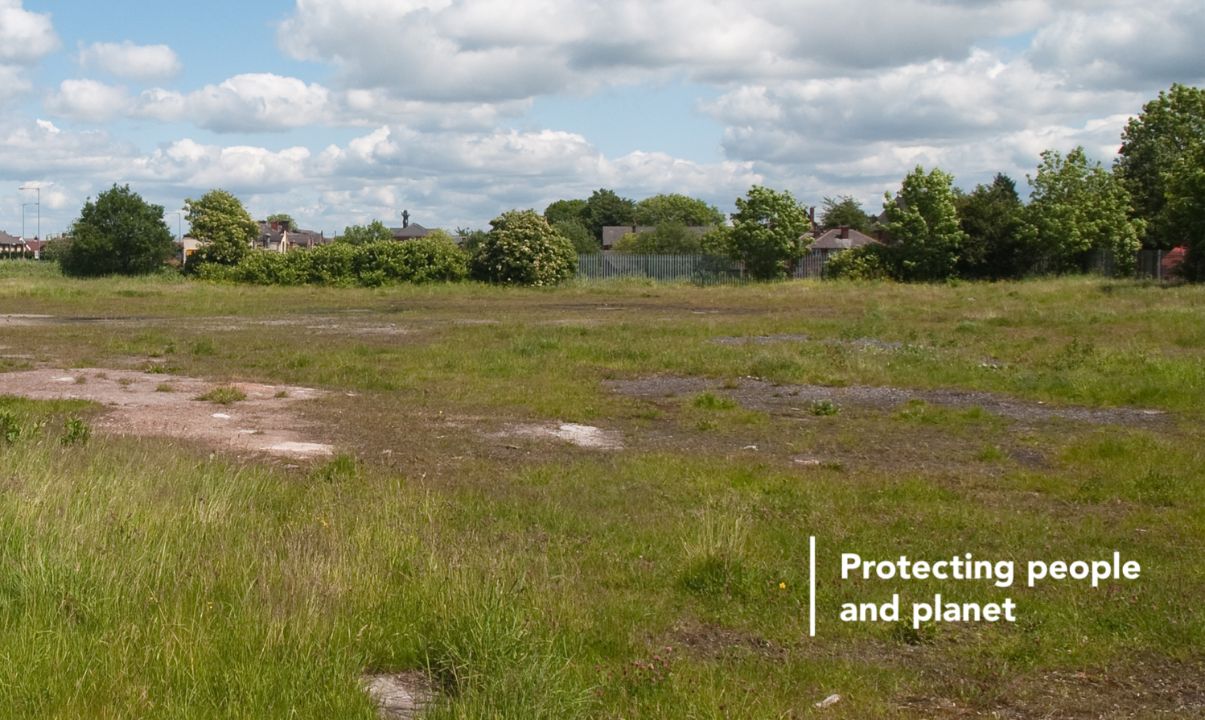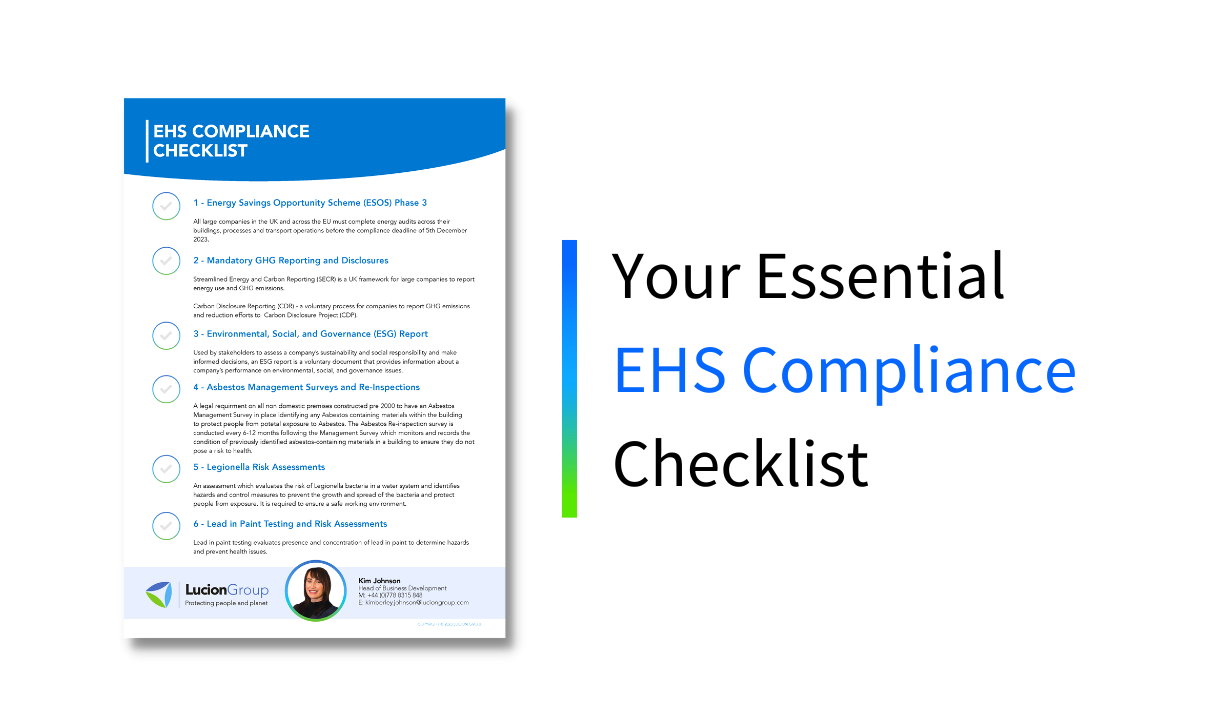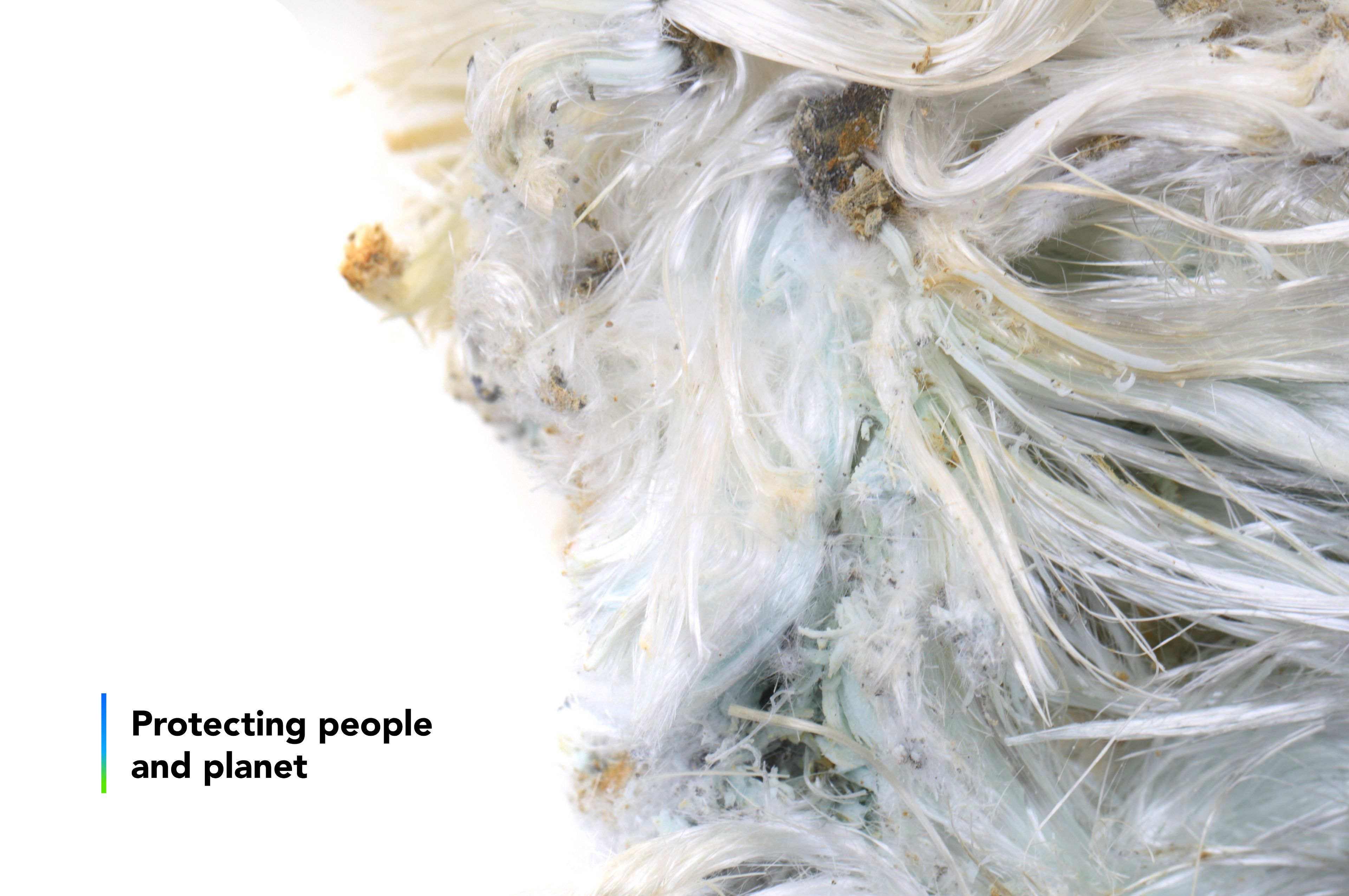Asbestos Risks on Brownfield Development Sites: The Importance of Effective Characterisation
30 January 2023
According to IBIS World, the market size of the Demolition industry in the UK has grown 0.3% per year on average between 2017 and 2022, although growth may not be on the cards due to the economic downturn felt across the industry. Despite the economic crisis and lasting effects of the pandemic, the appetite for commercial developments in the UK continues to rise with application approvals up by 9% in 2021 as reported by the Department of Levelling Up, Housing and Communities (DLUHC).
With the demolition and commercial development industry holding strong, it continues to be imperative for architects and developers to adequately plan for potentially hazardous materials including asbestos.
Lucion Group’s Head of Contaminated Land Services Alec Hales sheds light on the process of effectively managing asbestos in soils risk before commencing development and/or demolition projects.
As the demolition and development industry continues to grow, it is increasingly important for project teams to understand and manage associated asbestos risks.
Asbestos is a hazardous material that can cause serious health problems if inhaled. Failing to accurately assess and manage asbestos risks can lead to safety and legal issues, as well as costly fines and project delays.
This article will provide a thorough overview and explore the importance of characterising and managing asbestos risks on contaminated brownfield development sites involving Asbestos-Containing Materials (ACMs) and Asbestos-Containing Soils (ACSs).
Control of Asbestos Regulations, Guidance & Liabilities
The Control of Asbestos Regulations (CAR 2012) outline ‘duty-holder' responsibilities to manage asbestos risks in non-domestic premises. Requiring them to, amongst other things, identify the location and condition of asbestos in the premises i.e. carry out an asbestos survey and manage the associated risks to prevent harm to anyone who works on the building or the building occupants.
Typically for buildings and structures built pre-2000, an Asbestos Management Survey is required for all non-domestic premises, which is a minimum requirement to identify ACMs that could be potentially disturbed during normal occupancy. The other asbestos-related building surveys include Asbestos Re-Inspection Survey, Asbestos Refurbishment Survey and Demolition Asbestos Survey.
In terms of the definition of ‘premises,’ this also applies to outbuildings, external yards and land within the site boundary. In the context of CAR 2012 and land contamination, a site investigation/survey is required where there is a reasonable expectation that asbestos contamination is present with potential risks posed to workers. In addition to CAR 2012, there are various industry guidance documents and tools available, such as the Joint Industry Working Group's (JIWG) CAR-SOILTM industry guidance, HSE/HSG Surveyor and Analyst guides, CIRIA publications and the SoBRA Asbestos in Soil Human Health Risk Assessment (AiSHHRA) Toolbox.
For projects where ACSs are an issue, Lucion provides advice using a pragmatic stepped approach. This approach is designed to include an initial review and preliminary risk assessment elements through to on-site testing, inspection, sampling, supervision and monitoring. It provides robust data, information and advice, in line with current guidance and reassurance to our clients both in terms of health & safety risks and it aims to help reduce potential project delays.
It is worth highlighting that failure to assess and manage asbestos can lead to safety & legal issues, fines and project delays. In recent media coverage involving a Health & Safety Executive (HSE) prosecution, after workers were exposed to asbestos, the reported HSE inspector's comments on the case were as follows:
"The law requires businesses undertaking work in demolition, maintenance or any other work which exposes or is liable to expose employees to asbestos to assume ACMs are present unless you have evidence, such as an asbestos survey to indicate otherwise. The duty to manage asbestos relates to entire premises including yard areas, not just buildings. There is no safe level of exposure to asbestos.”
It is important to note that the regulations and law require work, which exposes or is liable to expose employees to asbestos, to be suitably risk assessed and investigated (often necessary), prior to carrying out other work. Site operatives must have the appropriate training and implement the necessary control and protection measures.
CAR-SOILTM industry guidance points out that a Licensed Work (LW) activity including supporting tasks and operations must be carried out by, or under the direct supervision of, a licensed asbestos contractor using a single Plan of Work. This would also include an ASB5 notification to be issued to the HSE 14 days prior to the work commencing.
Non-Licensed Work (NLW) and Notifiable Non-Licensed Work (NNLW) activities including supporting tasks and operations don’t need to be carried out by, or under the direct supervision of, a licensed asbestos contractor. However, the contractor must still be trained and competent under a Plan of Work (PoW), hold appropriate insurance, and implement the necessary site control & protection measures including the mandatory requirements for NNLW i.e. notification, medicals, maintenance of health record registers, and designated work areas.
Exposure incidents must be considered in line with HSE Reporting of Injuries, Diseases and Dangerous Occurrences Regulations (RIDDOR).
Land Contamination Assessment
When assessing and managing land contamination, asbestos is frequently a key contaminant which presents a risk to human health and therefore needs consideration under the relevant environmental legislation such as Part IIA of the Environmental Protection Act 1990 and the National Planning Policy Framework.
The Environment Agency (EA) sets out a staged approach to assessing and managing land contamination in their publication Land contamination risk management (LCRM) - GOV.UK (www.gov.uk):
- Stage 1 risk assessment (inc. exploratory investigation if required);
- Stage 2 options appraisal; and,
- Stage 3 remediation and verification.
Historical Context & Preliminary Risk Assessment (Asbestos)
For a proposed development site, developers must assess the potential for contamination to be present and, if contamination is suspected on a site, developers must submit assessments and reports to the Local Planning Authority (LPA) to ensure that the land is suitable for its intended end use. Initially, this may include a desk study containing a historical review, robust Preliminary Risk Assessment (PRA) and site walkover information. These assessments should consider the potential for ACSs as well as other contaminants.
For brownfield sites, in the context of asbestos contamination, it is necessary to consider both historical and current site activities including site features such as demolished buildings, old stockpiles, historical ground levelling works, landfilling, existing buildings/structures and potential illegal fly-tipping. All of the associated information can then help to identify the potential sources of asbestos contamination and determine the next stages for investigating and addressing the contamination.
Asbestos Investigation, Survey & Sampling
It is commonly known that ACMs were widely used in the construction of buildings and structures for many years. Over time, these materials can age, weather and degrade leading to fragments, clumps and asbestos fibres being spread into the surrounding environment. For decades, it was common demolition practice not to remove ACMs from buildings prior to demolition and therefore the presence of asbestos within Made Ground and soils from historical demolition practices and imported demolition materials used in land raising is very common. This legacy of poor demolition practices and unregulated ground filling is one of the main sources of ACS ground contamination.
As a typical planning requirement for a redevelopment, intrusive investigation is used to characterise a site regarding ground conditions, contamination and geotechnical assessments as any developer has a duty to ensure that post redevelopment, a site is safe for occupation. Soil testing/screening for asbestos is typically included within the initial site assessments, leading to further detailed testing and inspection if asbestos contamination is identified i.e. localised ‘hotspots’, stockpiles and localised maintenance works. The presence of asbestos can represent a risk both to those involved in the redevelopment process and to future site users and that risk must be appropriately characterised and managed. As the presence of asbestos within a soil or earthworks material fill may prevent its beneficial reuse and result in a material becoming costly to dispose of waste, appropriate advanced characterisation and assessment are essential.
Encountering previously undiscovered asbestos on large earthworks projects can stop works and lead to significant costs and unwanted delays. An investigation is also good practice prior to archaeological excavation works and vegetation clearance.
Investigation methods can include but are not limited to, exploratory boreholes, mechanical trial pits and hand-dug pits. Where there is a reasonable expectation that asbestos contamination could be present, these intrusive methods are used to excavate the underlying Made Ground soils to visually assess them for ACMs and also collect representative soil samples for laboratory testing.
Ground investigations and assessments should be designed by a competent person, this is highlighted in CAR-SOILTM industry guidance and defined in the National Planning Policy Framework (for England) as a person who has sufficient experience in dealing with the type of contamination, qualifications and is a member of a relevant professional organisation.
The data and information collected from ground investigations are used to assess ground contamination in terms of risks to human health and the environment that can feed into subsequent options appraisals and remediation strategy reports (if required). Therefore, it is important that the site investigation data provided is suitable, sufficient and the information is useful for the subsequent assessments.
When it comes to investigating asbestos-contaminated land, a combination of on-site observations, sampling and laboratory testing can be used to gather "lines of evidence" to determine the nature and extent of the contamination. It is necessary to gather detailed information including suspected bulk fragments and soil samples for laboratory testing (screening, identification and quantification).
Quite often asbestos contamination can be discovered during groundworks or late on in a project, which can cause health & safety issues and unwanted delays. Lucion will work with clients and apply the stepped approach. Further sampling and testing may be one of the options for understanding the extent of the issue and forming a safe solution.
Importance of Visually Identifying ACMs in Made Ground Soils
The release of asbestos fibres from soil can depend on factors such as the ACM type, condition (i.e. intact, weathered, degraded, disaggregated), the soil moisture content and the depth at which they are identified on or within the ground.
Lucion emphasises the importance of having trained, competent and experienced site operatives present on-site during asbestos site investigations and groundworks.
An experienced Asbestos Surveyor/ Engineer can manage and implement the appropriate control, and protection measures to minimise the risk of asbestos exposure during the excavation and testing process. For example, the use of Personal Protective Equipment (PPE) & Respiratory Protective Equipment (RPE), employing dampening down techniques and ensuring the necessary decontamination procedures for site personnel and equipment are correctly implemented.
It is important to have a robust sampling strategy. A fundamental part of asbestos in soil investigation is recognising visible suspected ACMs. They can be difficult to identify due to the many types of ACMs and their condition, combined with the surrounding soil matrices and other man-made constituents obscuring the visual assessment. Common visible ACM pieces found on brownfield sites can include loose asbestos, sprayed coatings, lagging/insulation, asbestos insulating board (AIB), millboards, asbestos paper, textiles/ropes, gaskets, asbestos cement, textured coatings, vinyl floor tiles and bitumen materials.
Pieces of ACMs visible to the naked eye can be assessed by a UKAS-accredited laboratory to determine or negate the presence of asbestos fibres (chrysotile, amosite and crocidolite). In contrast, soil samples where no visible pieces are easily identifiable may require UKAS-accredited laboratory testing to determine or negate the presence of microscopic pieces, fibre bundles and free fibres. The three stages of laboratory testing generally available include a Stage 1 screen and identification, followed by Stage 2 gravimetric quantification analysis and/or Stage 3 free/dispersed fibre analysis.
An Asbestos Management Plan (AMP) can provide a work category assessment to assess the licensing status for proposed site works, detailing the monitoring requirements and including the appropriate control and protection measures to protect on/off-site human receptors. An emergency strategy should also be included in an AMP in the event of unforeseen asbestos discoveries.
Is There a Safe Acceptable Level of Asbestos in Soils?
There is no safe level of exposure to asbestos and there is no safe concentration of asbestos in soils in the UK.
Works with ACSs are carried out using a risk-based approach, which typically includes a number of hazard and exposure factors assessed in order to determine the licensing status and necessary control and protection measures (i.e. PPE/RPE, dust suppression, decontamination procedures, cleaning plant/equipment, designated area(s), record keeping and monitoring).
Air monitoring data can be used to assess the potential risks associated with asbestos fibre release from soils, which is typically implemented during works to monitor and assess the suitability of the controls to ensure works carried out do not exceed the control Limit of 0.1f/cm3 (over four hours) and Short Term Exposure Limit (STEL) of 0.6 f/cm3 in the air measured over a ten-minute period. These control limits are set out within the Control of Asbestos Regulations 2012 (CAR 2012) and the associated Approved Code of Practice (ACOP) 143 respectively. Also, CAR-SOILTM refers to SALI - Sporadic And Low Intensity. It is important to note that the control limit is not a safe level of exposure from work activities and it must be reduced as low as reasonably practicable (ALARP).
Air Monitoring & Why Should I Use an Accredited Supplier
Phase Contrast Microscopy (PCM) is the UK standard method for the analysis of air when managing the risk of asbestos (HSG248). The PCM method is UKAS accredited and it measures the airborne concentration of countable fibres. Fibres that have consistent dimensional properties (i.e. within the correct range of width/length) to those of respirable asbestos fibres.
PCM air monitoring undertaken outdoors typically includes background, personal, near-source and far-source/perimeter monitoring. The recommended sampling parameters are detailed within HSG 248 (2nd Edition) Analyst’s Guide.
Ambient and environmental monitoring often require lower limits of detection and fibre discrimination. This can be achieved by extending the static pump durations on site and by employing more sensitive testing methods such as Scanning Electron Microscopy (SEM) laboratory testing.
UKAS accreditation confirms that all procedures, equipment, competencies and reporting practices meet the performance criteria set out in the ISO 17025 standard. Approval is only awarded after a rigorous audit and inspection process is carried out to ensure that the relevant sampling and analysis procedures are in place, laboratory professionals are properly qualified and trained to carry out the work expected of them with reporting and documentation is in line with the required formats.
In addition, Lucion’s laboratory has separate UKAS accreditation for SEM microscopy testing for very low quantities of asbestos fibres.
Lucion’s sampling and analytical capabilities mean our clients can benefit from higher limits of asbestos detection, providing greater levels of reassurance and confidence in the correct choice of risk management where it is required.
Asbestos In Soil Remediation & Validation Criteria
At present, there is no safe threshold for asbestos contamination in soil. A remediation strategy dealing with asbestos risks, typically assesses the feasible remediation options, risk assessment/receptor ranking and mitigation measures in order to reduce or remove potential risks posed to current users, workers and future end users of the site.
Common ACS remediation options can include:
- Leave in situ - only at depths where there is no requirement to remove or treat as part of the future works. This would normally be combined with ‘clean’ cover systems in private gardens and landscaped areas.
- On-site management i.e. excavation and placement of suitable materials on site. Again, this would normally be combined with the use of ‘clean’ cover systems in private gardens and landscaping areas. Best practice would likely involve the use of a Materials Management Plan (MMP) registered with the CL:AIRE Definition of Waste Code of Practice (DoWCoP) to manage such remedial works.
- On-site treatment. This would likely involve the removal of bulk asbestos fragments with subsequent placement of treated soils. A ‘clean’ cover system would be required. Best practice would involve the use of an MMP and there is likely to be a requirement for treatment works to be undertaken through the use of Environmental Permitting.
- Off-site treatment/reuse/recovery/disposal. Disposal to landfill should be considered to be the option of last resort in accordance with the waste hierarchy.
- Combination of all of the above.
For the reuse of soils, a remediation strategy can include site-specific remediation and validation criteria for contaminants (inc. asbestos) as well as specifying the required thickness of a cover layer/system, which is typically based on the sensitivity of the site and any associated risks to end users. A remediation strategy is normally required to be submitted to the Local Planning Authority (LPA) for approval prior to commencing the work.
As noted previously, best practice would normally dictate where ACSs are managed on-site either by excavation and placement or treatment and re-use where a MMP should be used. A Materials Management Plan that meets the requirements of the DoWCoP is reviewed by a suitably Qualified Person (QP) prior to commencing the work. If the QP is satisfied that the MMP meets the four overarching requirements of the DoWCoP, the QP will formally declare the MMP to CL:AIRE and the scheme can progress after paying the requisite registration fee. The four overarching requirements of the DoWCoP are:
- Factor 1: Protection of human health and protection of the environment.
- Factor 2: Suitability for use, without further treatment.
- Factor 3: Certainty of use.
- Factor 4: Quantity of material.
Note: the treatment of materials often also requires a relevant Environmental Permit or Regulatory Position Statement (RPS), specific to the activity to be in place.
Importantly, for imported topsoil/subsoil and/or site-won materials to be used as a ‘clean’ cover system, the materials used must be suitably and robustly characterised and free from any asbestos i.e. No Asbestos Detected (NAD) or Not-Detected. The Yorkshire and Lincolnshire Pollution Advisory Group (YALPAG) provides technical guidance regarding verification requirements for cover systems.
Asbestos In Soil Waste Classification
In terms of waste classification, it is important to assess potential contaminants that might be present at a site or within a particular material type. Clearly, this includes asbestos which can have a substantive impact on the classification of excavated materials where these need to be managed as a waste.
The Environment Agency provides technical guidance on the classification and assessment of waste (WM3 - Technical Guidance WM3: Waste Classification - Guidance on the classification and assessment of waste (1st Edition v1.2 GB). The WM3 guidance includes information on the assessment of asbestos-containing wastes (i.e. soils, construction and demolition wastes). It is important to consider both the presence of free, dispersed asbestos fibres as well as identifiable pieces of ACMs in the waste (i.e. any particle of a size that can be identified as potentially being asbestos by a competent person if examined by the naked eye).
If the waste contains fibres that are free and dispersed then the waste would be classified as hazardous waste if, as a whole, it contained 0.1% or more asbestos.
If the waste contains any identifiable pieces of ACMs, the concentration of asbestos in those pieces must also be assessed. If the concentration of asbestos in the piece is 0.1% or higher, it would be considered hazardous waste and should be classified as a mixed waste with appropriate codes.
Record Keeping
With technology so readily available electronic records of any potential asbestos identified during the site investigation can be kept in an easily accessible electronic format. Systems such as Lucion’s NexGen (purpose-built hazardous material compliance software for Lucion Services and the wider Lucion Group) enable clients to easily search for records on their sites, keep track of multiple projects and view reports as they progress through their lifecycle.
About The Author
Alec Hales is the Head of Contaminated Land at Lucion Services. He is a Chartered Environmentalist (CEnv) with the Institute of Environmental Sciences (IES) and holds a BSc in Environmental Science. He is also trained in the management of asbestos in buildings (P405).
Alec has over 17 years of experience in the environmental consultancy sector, working across a range of industries for both public and private clients. He manages contaminated land projects within Lucion's Infrastructure department and is responsible for developing solutions for complex asbestos-contaminated land schemes. He leads a team of experts in the infrastructure sector, including asbestos surveyors and analysts.
Alec's areas of expertise include asbestos in soil assessment, contaminated land assessment, remediation options appraisal, asbestos management plans and work category assessments/risk assessment (CAR 2012/CAR-SOILTM). He has experience in site investigation, human health & environmental risk assessment and remediation.
Tool Box Talk: Asbestos Awareness
As part of Lucion’s Take Care Be Aware initiative, we actively take care of our health and safety responsibilities, with continuous awareness of our commitments to knowledge share and educate.
In doing so we have created a ‘toolbox talk’ on asbestos awareness to raise awareness of the hazards associated with asbestos-containing materials, enabling safety professionals to share knowledge and overall save the time and effort in producing them for you and your teams.
_2.png)
Download From NexGen
Toolbox Talk: Construction Dust
Ensure your teams know the dangers of construction dust and what control measures and protection are required to manage the risks with this quick Toolbox Talk.
_1.png)
Download From NexGen
10 Steps To Asbestos Remediation
Puzzled by what is involved in the asbestos remediation process? Read our quick 10 step guide to your asbestos remediation project.
_1.png)
Download From NexGen
 NexGen
NexGen
























